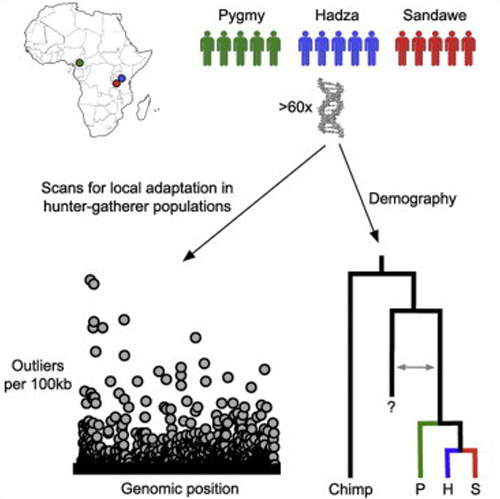Ancient Foreign DNA Found in Modern Human DNA
Source: earthfiles.com
“The group that we think contributed this foreign DNA to theseAfrican populations was much more closely related to anatomically
modern humans than Homo erectus. I think it is more appropriate to think
of this foreign group as about as different as Neanderthals were
to Cro-magnon Homo sapiens sapiens.”
- Joshua Akey, Ph.D., Assoc. Prof. of Genome Sciences, Univ. of Washington, Seattle

To reconstruct modern human evolutionary history, Prof. Akey and his Genome Sciences team at the University of Washington in Seattle, sequenced the whole genomes of five individuals in each of three different hunter-gatherer populations: Pygmies from Cameroon; the Khoesan-speaking Hadza and Sandawe from Tanzania. Graphic by Joshua Akey, Ph.D.

Until the late 1900s, many researchers believed that humans evolved from an apelike ancestor through a linear series of stages, but instead of smoothly evolving evolution, the truth is closer to many “branches of twigs” from a large, family tree that has unexpected and unidentified “foreign DNA” from the distant past. Graphic source DNA Learning Center.
The August 3, 2012, issue of the journal Cell featured a new DNA study of three African populations that provoked the Seattle Times to headline: “Sex with Early Mystery Species of Humans Seen in DNA.” The subject is foreign DNA that does not resemble DNA from any modern humans and not even from Neanderthal DNA. Was it ancient sex? Or genetic manipulation of already-evolving primates by non-human intelligences terraforming Earth as described in leaked, alleged government documents shown to me and others since at least the early 1980s?.
The DNA samples were collected by Sarah Tishkoff, Ph.D., Corresponding Author on this genome study in the Departments of Biology and Genetics at the University of Pennsylvania in Philadelphia, Pennsylvania. She worked with five people in three different African groups: the small pygmies from Cameroon; and the Hadza and Sandawe from Tanzania.
At the University of Washington’s Medical Center in Seattle, Professor Joshua Akey, Ph.D., in Genome Sciences, had each genome in Dr. Tishkoff’s samples scanned some 60 times to look for genetic code variations that could help explain differences between individuals and populations. Over 13.4 million genetic variants turned up. 3 million of those had never before been seen in humans. One distinctive variant in all three populations studied were genes that produced blood compounds that speeded repair of injuries. That foreign DNA’s influence might explain over time why certain bloodlines of some modern humans heal better than others.
Quoting from the July 26, 2012, issue of ScienceNow about the foreign DNA discovery, “What has most intrigued some researchers is that the study found genetic evidence that all three groups had intermingled sexually with an unknown, older species.”
Read the rest of the article here






















